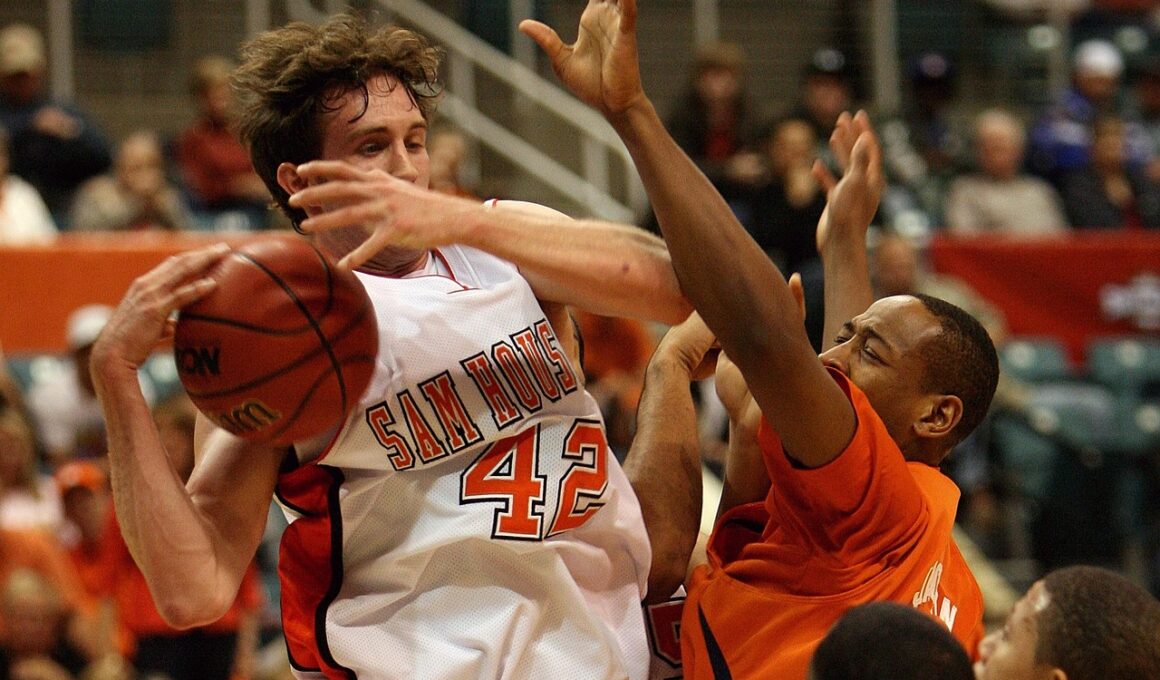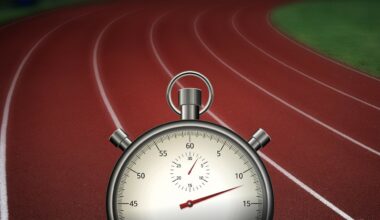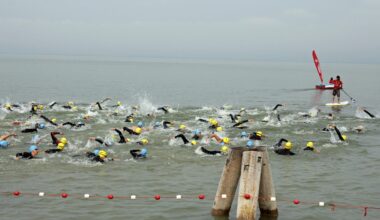Explosive Rebounding Drills for Increased Court Presence
Rebounding is a critical skill in basketball. Players often underestimate the importance of being effective on the boards. This guide is designed to help you improve your rebounding techniques through explosive drills that will enhance your court presence. Understanding rebounding fundamentals is essential. You must focus on positioning, timing, and technique to secure the ball effectively. Start by practicing the basic stance. Maintain a low center of gravity, keep your feet shoulder-width apart, and ensure your knees are slightly bent. This stance allows you to react quickly and maintain balance, providing an edge over your opponents. Visualize the ball’s trajectory; this skill improves anticipation. Always walk through your drills with intensity and purpose. It’s not enough to just be present at the rim; instead, you need to battle for every rebound. Analyze your positioning and always be aware of your competitors by sight and sound. Communication with team members can also increase your chances of securing rebounds effectively. Being vocal assists everyone on the court. Keep pushing your limits to master these explosive techniques that can elevate your game.
Drill One: Box Out Technique is critical when considering rebounding efficacy. This skill can significantly boost your chances of grabbing a rebound. Begin by practicing with a partner. One person will shoot while you focus on your established positioning in relation to the basket. As soon as the shot goes up, initiate the box out. Position your body between the defender and the basket. Use your arms and body to create a barrier. If you are active and aggressive, it increases your winning potential for the ball. Another key component is to use your hips effectively. Engaging your hips will grant you superior leverage in the battle for the ball. Remember to maintain eye contact with the shooter while determining the ideal timing for a jump. Anticipate when to leap using rhythm instead of height alone. Avoid excessively jumping too early or late; this timing is crucial. To enhance your skills, practice this technique multiple times in a row without stopping. Repetition leads to mastery of this vital skill. Organize friendly competitions within training sessions for better engagement. Track each other’s improvement, as healthy competition fuels growth.
Drill Two: The Jump and Reach
This drill focuses solely on vertical leap and explosiveness. Footwork plays an essential role here, so ensure you are working out in a suitable space. Start from a low position; have your feet firmly planted and your knees bent. Use your arms to generate momentum by swinging them backward. As you explode upwards, ensure your arms are extended toward the rim to maximize reach. Jump as high as possible while keeping your eyes locked on the ball. Integrate this jump into various exercises to improve dynamic reactions on the court. To further develop your vertical leap, consider adding plyometric exercises to your regimen. Box jumps, squat jumps, and depth jumps are excellent choices. Set goals for your vertical improvements each week. Focus on incremental changes, as tiny gains add significant overall improvement over time. Remember to allow your body time to rest; adequate recovery is vital for explosive power development. Utilize feedback from teammates to enhance your jumps. These small adjustments can make a huge difference. Consistent practice of the jump and reach drill allows players to develop confidence in their rebounding position.
Drill Three: The Rebound Chase, is another essential exercise every player should include in their practice schedule. This drill simulates actual game situations effectively, helping players react quickly to ball rebounds. Start by placing a basketball at various locations around the court. Share dynamic responsibilities with a teammate or coach during the practice. Whenever a shot is attempted, quickly follow the ball to its trajectory. As the shot is taken, anticipate missed attempts to finish the drill. Switch roles frequently between shooter and rebounder so both legs and techniques are worked accurately. Don’t forget to practice chasing the ball from different angles. Be prepared to adjust your body positioning quickly and effectively based on the ball’s movement. Setting a timer can turn this into a competitive exercise, allowing players to focus on quickness and reaction time. Count the total rebounds captured within a set time limit. Work towards improving your score each session. This drill emphasizes proactive movement over reactive skill sets. Over time, you will notice improved court awareness and power in your rebounds.
Drill Four: The Box-Out Battle
In this drill, you practice the box-out technique against a partner to create real-game scenarios. Start by choosing a designated area to battle for rebounds. One player takes a shot while the other must box them out effectively. Initially, you might engage in a 1-on-1 situation to gauge your skills. Focus on body positioning and feel how your body can leverage the opponent’s expectations. Utilize your strength to gain prime court position and react quickly. If you get pushed out, strive to improve your positioning over time through practice and monitoring. A combination of resistance with a partner enhances the learning curve dramatically. Have your partner attempt to maneuver around you while you remain focused on your box-out technique. Monitor your stability and adaptability during these trials. Concentrate on using your core to balance and stay low while maintaining a solid base. This improves body control and increases competitiveness. A great goal is to take turns for 3 to 5 minutes as each player rotates through the position. Keep engaging your opponent with agility.
Drill Five: The Tap and Go, is a dynamic drill that emphasizes agility and decision-making skills during rebounding situations. Start at the free-throw line and sprint toward the basket as a teammate takes a shot. As you approach the basket, practice tapping the ball off the backboard or rim to your teammates, who will also be following in. This requires anticipating where rebounds are likely to go and making a split-second decision. Timing and communication are essential; creating a seamless connection between the player shooting and the rebounders is crucial. Make this exercise more exciting by introducing rules or shooting techniques. Varying the style of shots taken will allow you to practice accordingly. Increase the difficulty as proficiency improves by limiting the number of rebounds each player can grab. Encourage players to maintain an upbeat intensity. Being engaged and energetic during practice creates excellent habits. Always remember to analyze and recap the drills at the end of each session. Go over successes and areas needing improvement. Allow feedback from coaches as well to further refine your skills based on proven experiences.
Final Thoughts on Rebounding
Rebounding is not just about individual effort; teamwork is vital for success. Every player on the court has a role in boxing out opponents or clearing space for rebounders. Therefore, communication plays a crucial role in creating effective rebounding strategies. Establish signals or terms among players to indicate a rebound is needed, ensuring everyone is aware. Developing trust with teammates allows for better coordination during games. Cultivating a rebounding mindset enhances overall performance on the court. Players need to approach every shot, regardless of whether they’re on offense or defense, with the intention to grab a rebound. By nurturing the skills mentioned throughout this article, players can enhance explosive abilities, positioning, and teamwork—the overall aspects of effective rebounding. Always maintain focus and energy, as these drills are building blocks for future success. Stay committed to regular practice, review techniques often, and evaluate progress. Also, recognize that improvement takes time and perseverance; be patient with yourself. Ultimately, explosive rebounding will create a greater presence on court, making you a formidable asset to your basketball team.
Incorporating conditioning workouts can significantly increase rebounding performance. Enhanced fitness translates to better endurance, enabling players to maintain energy throughout the game. Consistency in both skill drills and conditioning exercises will result in improved performing levels. Resistance training, alongside basketball drills, helps develop essential strength components needed for rebounding efficiency. Focus on compound movements that harness the full body. Weight training of muscle groups utilized during rebounds optimally prepares players for the physical demands of the game, ensuring success in competitive environments. Utilizing bodyweight exercises such as squats, lunges, or push-ups promotes overall fitness. Additionally, practice agility drills to enhance quick feet would prove to be beneficial. Incorporating cardiovascular exercise in regimens will also enhance stamina, making players fiercer competitors. Recognize that conditioning is not solely based on mere endurance, but also speed and agility. Enlist professionals providing tailored fitness plans to fit personal needs optimally. By synchronizing workouts with basketball training, players witness more noticeable improvements over time. Ultimately, the goal is to become a versatile athlete capable of performing at high levels across multiple aspects of the sport.


